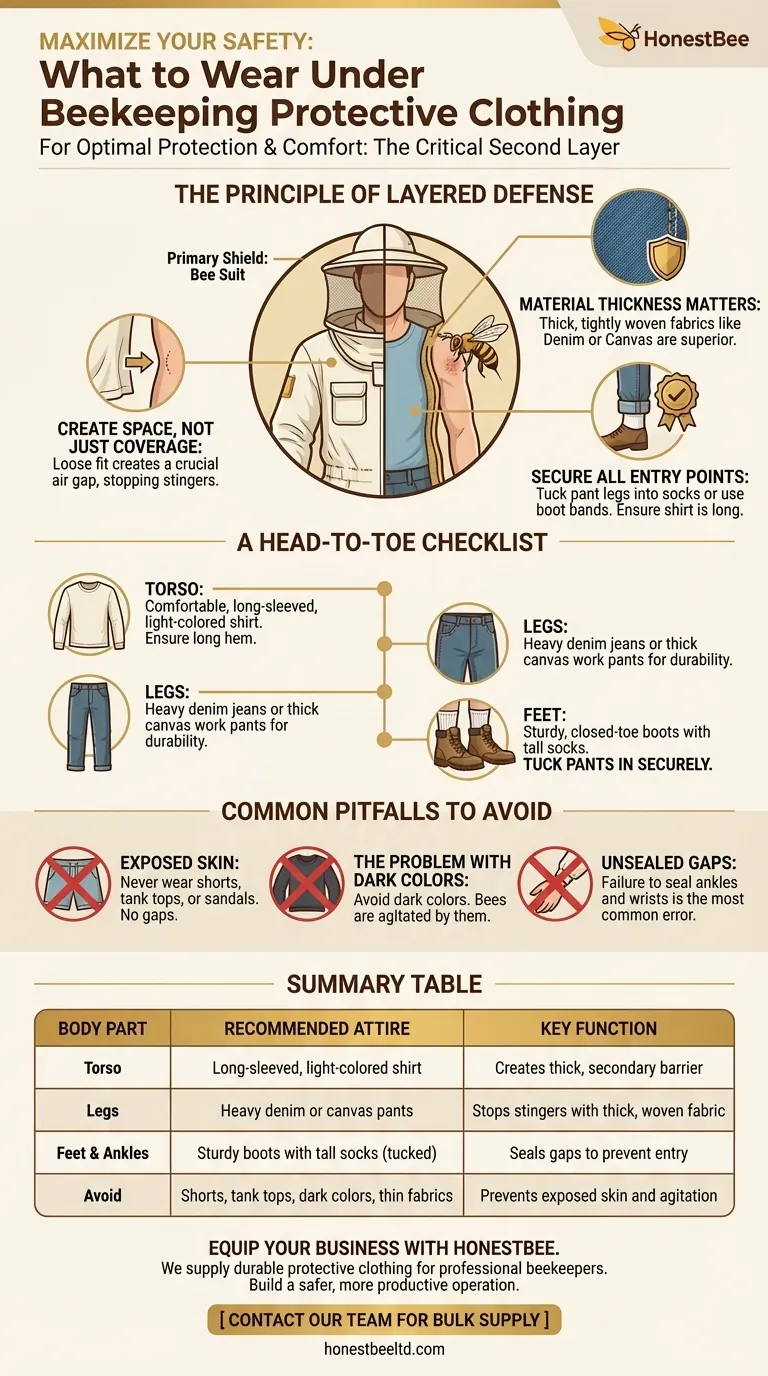For optimal protection, you should wear thick, light-colored clothing underneath your beekeeping suit. The best choices are a long-sleeved shirt, heavy denim jeans or canvas pants, and sturdy, closed-toe boots with tall socks. The goal is to create a secondary barrier and ensure there are no gaps for bees to enter.
Your clothing under the bee suit is more than just an outfit; it is a critical second layer of defense. Its primary purpose is to create space and add thickness, making it difficult for a bee's stinger to reach your skin even if it penetrates the suit.
The Principle of Layered Defense
A bee suit is your primary shield, but the clothes you wear beneath it provide essential backup protection and peace of mind. Understanding why certain clothes work better than others is key to staying safe and comfortable.
Creating Space, Not Just Coverage
A honey bee's stinger is relatively short. Loose-fitting clothing creates a crucial air gap between the fabric and your skin.
If a bee attempts to sting through your suit and the underlying fabric, this gap often prevents the stinger from being long enough to make contact.
Material Thickness and Texture
Thick, tightly woven fabrics like denim or canvas are superior choices. They are much more difficult for a stinger to penetrate compared to thin materials like athletic wear.
Avoid flimsy or clingy fabrics that offer little resistance and sit directly against your skin, negating the benefit of a second layer.
Securing All Entry Points
Bees are opportunistic and will exploit any opening. A common mistake is leaving a gap between your pants and footwear.
Always tuck your pant legs securely into your socks or use boot bands. Likewise, ensure your shirt is long enough that it won't expose your back when you bend over.
A Head-to-Toe Checklist for Under-Suit Attire
For a clear, systematic approach, follow this checklist every time you prepare to visit your hives.
For Your Torso
Wear a comfortable, long-sleeved shirt. A simple t-shirt or collared work shirt made of a durable material is ideal. If you wear low-rise jeans, choose a shirt with a long hem.
For Your Legs
Choose thick denim jeans or heavy canvas painter's or work pants. These provide the best combination of thickness and durability to stop a stinger.
For Your Feet
Wear sturdy, closed-toe boots or high-top shoes. Always wear socks that are tall enough to allow you to securely tuck your pant legs into them, creating a complete seal.
Common Pitfalls to Avoid
What you don't wear is as important as what you do. Avoiding these common mistakes will significantly reduce your risk of stings.
Exposed Skin is an Invitation
Never wear shorts, tank tops, or sandals, even on a hot day. Any exposed skin completely bypasses the protection your suit is meant to provide.
The Problem with Dark Colors
Bees are naturally agitated by dark colors, which they may associate with predators like bears or skunks. Always opt for light-colored clothing (white, khaki, light gray) under your suit to minimize agitation.
Forgetting to Seal the Gaps
The most common points of failure are the wrists, ankles, and neck. While your suit and gloves handle the wrists, you are responsible for the ankles. Double-check that your pants are tucked into your socks before putting on your suit.
Making the Right Choice for Your Goal
Your clothing choices should align with your comfort level and the temperament of your bees.
- If your primary focus is maximum safety (especially for beginners): Always wear thick jeans, a long-sleeved shirt, and securely tucked socks under your full suit.
- If your primary focus is managing heat in a calm hive (for experienced beekeepers): You might opt for lighter-weight canvas pants, but never compromise on full coverage or sealing the gaps at your ankles.
Proper preparation is the foundation of confident and enjoyable beekeeping.
Summary Table:
| Body Part | Recommended Attire | Key Function |
|---|---|---|
| Torso | Long-sleeved, light-colored shirt | Creates a thick, secondary barrier |
| Legs | Heavy denim or canvas pants | Stops stingers with thick, woven fabric |
| Feet & Ankles | Sturdy boots with tall socks (pants tucked in) | Seals gaps to prevent bee entry |
| Avoid | Shorts, tank tops, dark colors, thin fabrics | Prevents exposed skin and bee agitation |
Equip your commercial apiary or distribution business with the right gear from the start. At HONESTBEE, we supply the durable protective clothing and equipment that professional beekeepers rely on for safety and efficiency. Let our wholesale-focused expertise help you build a safer, more productive operation.
Contact our team today to discuss your bulk supply needs.
Visual Guide

Related Products
- 3 Layer Mesh Vented Sting Proof Beekeeping Suit with Hat and Veil
- Vented Beekeeping Jacket with Hood and Veil for Beekeepers
- Cotton Beekeeping Suit and Round Hat with Veil Bee Keeper Protective Gear
- Yellow Plastic Bucket Pail Perch for Beekeeping
- Long Langstroth Style Horizontal Top Bar Hive for Wholesale
People Also Ask
- What should be considered regarding the color of beekeeping clothing? Ensure Your Safety and Keep Bees Calm
- Why do beekeepers wear suits? Essential Protection for Hive Management
- What features should be considered for sting protection in a beekeeping suit? Ensure Total Safety and Comfort
- What are the key features of the 3-layer mesh gear designed for beekeeping? Superior Protection & Ventilation
- What should be considered when fitting beekeeping clothing? The Essential Guide to Safety & Comfort



















